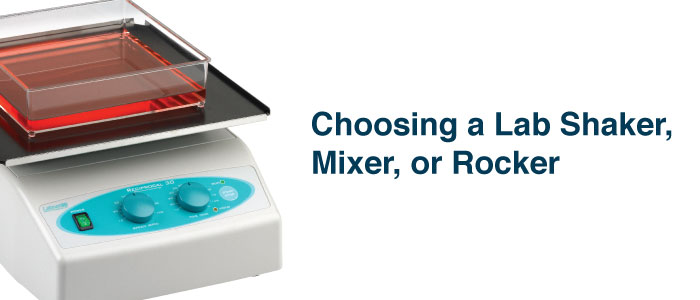
Lab Sample Rotator Reference Guide
10 Sep 2013
Get Help Choosing the Right Shaker, Rocker, or Laboratory Mixer
You know you need new laboratory equipment to help you complete important functions in the lab, but you may not be sure which is right for you - with a variety of options to choose from to help you stir your laboratory samples, knowing more about your specific needs should help you whittle down your choices. Below we have a quick reference guide to help you decide: laboratory shaker, lab rocker, or lab mixer?
All lab shakers are not created equal, but they are all created to do more or less the same thing - stir your samples. How a Lab Sample Rotator goes about this seemingly simple task, however, is quite different.
The laboratory shaker: Lab shakers are designed to mix samples by way of a left to right, linear motion. Laboratory shakers can be utilized for a variety of containers, including micro tubes, microplates, flasks, bottles and dishes. Laboratory shakers are widely used in cell culture, and additional variations including orbital shakers (these shake in a circular motion) and reciprocal shakers are also used, and shaking laboratory incubators combine shaking and heating into one application to speed up processes in the lab. Lab shakers generally have multiple settings for gentle or more vigorous mixing.
The rocker: Laboratory rockers like Labnet's ProBlot™ 35 Deluxe Rocker are also used to mix laboratory samples, but rockers employ a gentle rocking (tilting) motion in order to do so. The rocker is often used for more delicate applications including gel staining following electrophoresis. Rockers are also available in a variety of sizes and can handle a wide range of lab containers including flasks, test tubes, and dishes.
The mixer: Combining the best of all worlds, a laboratory mixer mixes samples in 3-D, that is, it works by combining the movements of a rocker and a shaker to create a 3D motion. Mixers can be helpful for applications that require thorough mixing but gentle handling of samples, or for very high rpms like those found with Labnet’s VX-200 Vortex mixer. Rotators are also used in sample mixing applications for molecular biology, biochemistry, and clinical testing. Rotators hold sample tubes and works by rotating, rocking and tumbling samples in order to mix samples horizontally and vertically. The rotator can be configured and customized to your lab’s unique needs.
Learn more about any of Labnet’s laboratory shakers, mixers by visiting our Shakers, Rockers, and Rotators section.

